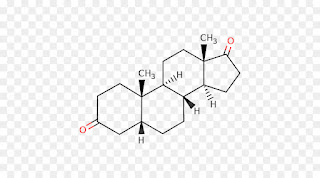Androstenedione is a steroid hormone, often known as a 'pro-hormone,' that is generated primarily in men's testes and women's ovaries and is used to boost the synthesis of the hormones testosterone and oestrogen
 |
| Androstenedione |
Androstenedione became well-known after being used by
baseball homerun batter Mark McGwire and other elite athletes. The Anabolic
Steroid Control Act of 2004 was signed into law in the United States in January
2005. Androstenedione was reclassified from a dietary supplement to an anabolic
steroid, which is classed as a schedule III prohibited drug. The National
Collegiate Athletic Association considers androstenedione to be a prohibited
drug (NCAA).
Androstenedione
is a steroid hormone used by the body to make testosterone and estrogen. Androstenedione
is taken orally specifically to increase the testosterone level. By boosting
testosterone levels, androstenedione is believed to improve the athletic
performance, enhance recovery and growth from exercise, increase energy, keep
red blood cells healthy, and increase the sexual desire and performance.
In females, androstenedione is released into the circulation
via the outer section of the adrenal glands (known as the cortex) and the
ovaries, where it is converted to supply around half of all testosterone and
virtually all of the body's oestrone, a kind of oestrogen. Although male testes
make a lot of androstenedione, they don't release much of it into the
bloodstream and instead convert it to testosterone within the testes. In males,
the adrenal glands also produce androstenedione, but this is overshadowed by
the testes' production of testosterone, the other androgenic hormone.
How is
androstenedione controlled?
Androstenedione's management inside the body is complicated
due to its release from a variety of glands and its frequent conversion to
other hormones. The hypothalamus and pituitary gland, however, are known to
have a role in the modulation of androstenedione production from the testes,
ovaries, and adrenal cortex.
The adrenal cortex's production of androstenedione is
hypothesised to be linked to the pituitary gland's secretion of a specialised
hormone known as adrenocorticotropic hormone. It's unknown how
adrenocorticotropic hormone and other hormones regulate androstenedione
synthesis in the adrenal gland. Luteinising hormone and follicle-stimulating
hormone induce the release of androstenedione in the testes and ovaries.
More Reports Related
to Pharmaceuticals Industry- https://bit.ly/3iQ6fpa
What happens if I
have too much androstenedione?
Too much androstenedione in males can cause an imbalance in
oestrogen and testosterone production, which can result in changes like breast
growth. Other changes, such as the testes shrinking, may occur depending on the
origin of the excess androstenedione.
Excessive body and facial hair development (hirsutism), the
cessation of periods (amenorrhoea), severe acne, and changes to the genitalia
are all possible side effects of too much androstenedione in women.



Comments
Post a Comment